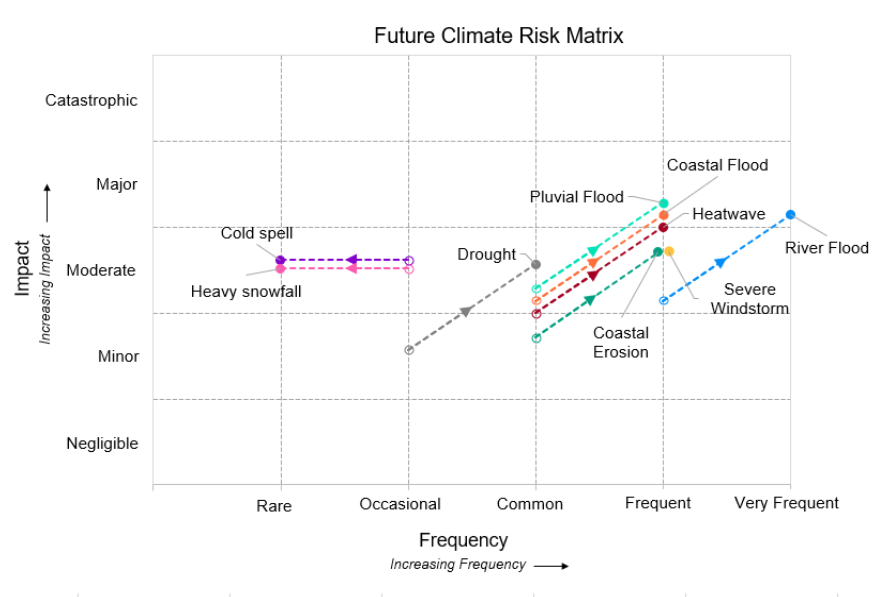- What, in your opinion, are the priority climate related risks for County Sligo?
- How can Sligo County Council support your community to adapt or build resilience to the impacts of climate change?
- How can Sligo County Council support the use of Nature Based Solutions in adapting to the impacts of climate change?
Climate Action - Adaptation
4.5 Climate Action: Adaptation
Climate adaptation involves taking action to prepare for and adjust to the current and future impacts of climate change. Understanding the risks posed by climate change is an essential first step for Sligo County Council to develop effective and efficient adaptation actions in response to current and projected climate change. Climate change risk assessments identify the likelihood of future climate hazards and their potential impacts. This is fundamental for informing the prioritisation of climate action and investment in climate action.
As part of the Building the Evidence Phase baseline Climate Risk Assessment was carried out to assess the current and future climate risks for Sligo. The Climate Risk Assessment can be viewed in more detail in the Climate Change Risk Assessment report on the Home page of this consultation.


Figure 4.1: Climate risk matrix showing the future change in risk with the hollow marker showing the current risk and the solid marker the future risk. The dotted line shows the change between the current and future risk.
- Recent experiences of cold spells and heavy snowfall events in 2018 and 2022, demonstrated the wide range of impacts for County Sligo. These included, amongst others, disruption to public transport networks and road closures. Projected increases in average temperature and decreases in the frequency of snowfall indicate a decrease in the frequency of cold spells, heavy snowfall, and their associated impacts.
- Recent experiences of river and pluvial flooding events in 2020 and 2021 demonstrated the wide range of impacts for the county. These impacts included damage to residential properties, closure of businesses, disruption to public services and closure of transport networks. Projected increases in the frequency of extreme precipitation events will result in increased surface water and riverine flood risk for Sligo.
- County Sligo experiences coastal erosion and coastal flooding events on a common basis, with recent events in 2021 and 2022 resulting in disruption of transport networks and damage to coastal habitats. Projected sea level rise and increased storm frequency will increase the frequency of coastal inundation and erosion events and associated impacts.
- Heatwaves and droughts have contributed to the imposition of restrictions on water supply, damage to road surfaces and have placed an increased demand on recreational areas. The Risk Assessment has determined that these events will become a common occurrence in the future.
Sligo County Council are already very active in adapting and building resilience to the impacts of climate change, such as through flood defence schemes (in conjunction with the OPW), planning, risk assessment, and maintenance and strengthening of infrastructure.
To increase resilience, Sligo County Council will need to proactively plan for and work with our communities and government agencies to adapt to the current and future climate change risks identified.
Sligo County Council’s Climate Adaptation Strategy which was adopted in 2019 and has further details regarding climate risk & adaptation, as well as a list of actions, is also available at the link provided.
Whilst all adaptation methods will be considered, Sligo County Council is committed to exploring the feasibility of Nature Based Solutions (NBS) wherever relevant. NBS can be described as being interventions which incorporate elements of the natural habitat to deal with issues.
The European Commission defines NBS as being:
“Solutions that are inspired and supported by nature, which are cost-effective, simultaneously provide environmental, social and economic benefits and help build resilience. Such solutions bring more, and more diverse, nature and natural features and processes into cities, landscapes and seascapes, through locally adapted, resource-efficient and systemic interventions.”
Nature-based solutions must therefore benefit biodiversity and support the delivery of a range of ecosystem services. Examples of NBS which would be applicable to the Sligo landscape would be sand dune regeneration, bogland rewetting, afforestation, SUDS and green roofs, although this list is not exhaustive.
We are looking for your input to help us shape appropriate adaptation actions in our Local Authority Climate Action Plan.